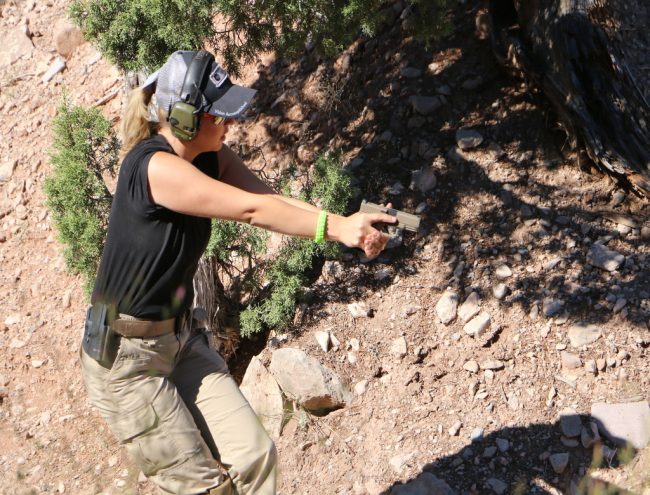As the number of female concealed-carry holders rises around the country, we’re seeing more women at the range for practice. Regularly managing a learned firearm skill set can be a major challenge to fit into our busy lives, but the kind of training we do in the little time we have is vitally important.
For understandable safety reasons, many ranges only allow patrons to shoot at paper targets while standing on a firing line. Throwing lead downrange in a stationary position can be helpful to correct minor issues like grip and trigger slap, but women serious about carrying a gun for self-defense should regularly train in a location where they can get out and move their feet. Athletes are told to train in the same way they compete. Training to save your life is no different, and far more important.
When a situation arises in real life that requires defensive action, it won’t happen slowly in a single lane or from one direction. Instead, it will happen quickly, and your ability to move and get yourself out of it will be a major factor in survival. Training to spot a threat, manage it and get away is a top priority. Reenactment of these types of scenarios is crucial for mental conditioning and preparedness.

Because many indoor ranges do not allow holster draw, movement while shooting, rapid fire or double taps, women (and men) should seek out training academies with individual outdoor bays. Look for an outdoor training academy with memberships, rather than a range set up to get as many people in and out as possible. After a reminder about safety rules, many training academies allow shooters to set up different scenarios on their own, tailored to their individual needs.
For women who carry a handgun off-body, training with the bag or purse you regularly use in everyday life will make a real-life situation less stressful. Is the handgun easy to get to while walking? How quickly can you get it out? What if you’re carrying something else and have only one hand free—then what? All these scenarios should be played out in an open shooting bay, not in one where mobility is limited.
For examples of where to go, check out the United States Shooting Academy in Tulsa, Oklahoma, and Peacemaker National Training Center in Gerrardstown, West Virginia. Classes like those offered at Gunsite Academy (with locations in Arizona, Kansas and Virginia) can teach you drills to practice closer to home in places where you’re allowed to move and draw from a holster.
To be clear, there’s nothing wrong with hitting the range to shoot at paper targets. You should still do this as often as possible, since this type of practice no doubt helps with skills upkeep. But integrating movement scenarios into your training routine will not only make you a better shooter, but you’ll also be better mentally prepared and conditioned to react effectively when presented with a bad situation.
The kind of training we do in the little time we have is vitally important.
Katie Pavlich is passionate about shooting and hunting. She’s also an advocate of the Second Amendment over at Townhall.com and FOX News. View all posts by Katie Pavlich